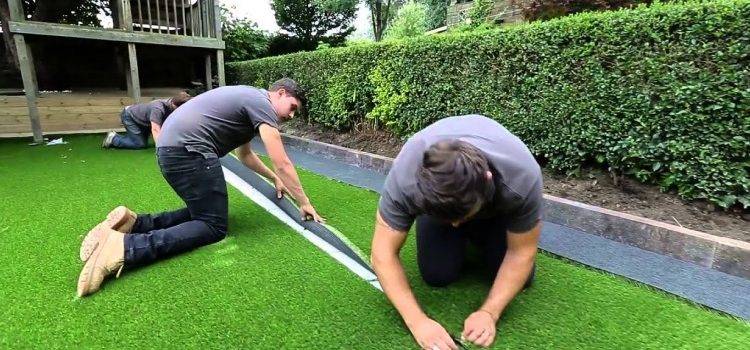When selecting turf for a lawn, several factors must be considered. Climate is a primary consideration, as different turf varieties thrive in specific weather conditions. The amount of foot traffic the lawn will experience is also important, with high-traffic areas requiring more durable turf varieties.
Maintenance requirements vary among turf types, with some needing more frequent mowing and fertilizing than others. The aesthetic appeal of the turf is another factor to consider, as varieties can range from lush, dark green to lighter, more delicate appearances. In regions with hot, dry summers, drought-tolerant varieties are preferable, while cooler, wetter climates may require different turf types.
The amount of shade in the yard is also significant, as some varieties are more shade-tolerant than others. Soil type is another crucial factor, as certain turf varieties perform better in sandy, clay, or loam soils. The desired texture of the lawn should also be taken into account, with options ranging from fine to coarse appearances.
By carefully considering these factors, homeowners can select the most suitable turf variety for their specific needs and preferences.
Key Takeaways
- Choose turf that is suitable for your climate and intended use
- Prepare the ground by removing weeds, leveling the soil, and adding organic matter
- Install the turf carefully, ensuring it is laid tightly together with no gaps
- Water the turf regularly, especially during the establishment period, and fertilize as needed
- Maintain the turf by mowing, aerating, and addressing any pest or disease issues
- Troubleshoot common issues such as yellowing grass or bare patches
- Enjoy your new lawn by spending time outdoors and hosting gatherings
Preparing the Ground
Clearing the Area
Start by removing any existing grass, weeds, or debris from the area where you plan to lay the turf. This can be done using a shovel or a sod cutter, depending on the size of the area.
Soil Preparation
Once the area is clear, it’s important to till the soil to a depth of at least 4-6 inches to loosen it and improve drainage. This will also help to create a level surface for laying the turf. After tilling, it’s important to amend the soil with organic matter such as compost or peat moss to improve its fertility and structure.
Ensuring Proper Drainage and Compaction
Preparing the ground for turf installation also involves ensuring proper drainage in the area where the turf will be laid. If the soil in your yard tends to hold water or become waterlogged, it’s important to address this issue before laying the turf. This can be done by incorporating sand or other amendments into the soil to improve its drainage capabilities.
Additionally, it’s important to grade the area to ensure that water will flow away from buildings and other structures, preventing potential water damage. Finally, it’s important to compact the soil to create a firm, stable base for the turf. This can be done using a lawn roller or by simply walking over the area to press the soil down.
Installing the Turf
Once the ground has been properly prepared, it’s time to buy the turf and install it. Start by laying the first row of turf along a straight edge, such as a driveway or sidewalk, ensuring that each piece is snugly butted up against the next. It’s important to stagger the seams of each piece of turf to create a more natural appearance and prevent gaps from forming.
As you lay each row of turf, be sure to press down firmly on each piece to ensure good soil contact and eliminate air pockets. It’s also important to avoid stretching the turf as this can lead to shrinkage and gaps between pieces over time. When installing turf, it’s important to handle each piece carefully to avoid damaging the delicate roots and grass blades.
It’s best to work quickly and efficiently to minimize the amount of time that the turf is exposed to air and sunlight. If possible, it’s best to install turf on a cool, overcast day to reduce stress on the grass and give it the best chance of establishing strong roots. After all of the turf has been laid, it’s important to water it thoroughly to help settle the soil and encourage root growth.
Be sure to water deeply enough to penetrate the soil beneath the turf and keep it consistently moist for the first few weeks after installation.
Watering and Fertilizing
After installing new turf, it’s crucial to establish a proper watering and fertilizing routine to promote healthy growth and long-term success. In the first few weeks after installation, it’s important to water the turf deeply every day to keep the soil consistently moist and encourage strong root development. As the turf becomes established, gradually reduce watering frequency but increase the amount of water applied each time to encourage deeper root growth.
It’s important to water early in the morning or late in the evening to minimize evaporation and ensure that the water has time to penetrate deeply into the soil. In addition to proper watering, it’s important to fertilize new turf to provide essential nutrients for healthy growth. Start by applying a high-phosphorus fertilizer shortly after installation to promote strong root development.
After about six weeks, switch to a balanced fertilizer with equal parts nitrogen, phosphorus, and potassium to encourage overall growth and health. It’s important not to over-fertilize as this can lead to excessive top growth and weaken the roots. By establishing a proper watering and fertilizing routine, you can ensure that your new turf will establish strong roots and thrive for years to come.
Maintaining the Turf
Once your new turf is established, it’s important to maintain it properly to keep it looking its best and ensure long-term health and vitality. Regular mowing is crucial for maintaining a healthy lawn, but it’s important not to cut too much off at once as this can stress the grass and lead to brown patches. It’s best to mow when the grass is dry and use a sharp blade to create clean cuts that will heal quickly.
Additionally, it’s important not to mow too short as this can weaken the grass and make it more susceptible to pests and diseases. In addition to regular mowing, it’s important to aerate your lawn at least once a year to relieve compaction and improve air and water penetration into the soil. This can be done using a core aerator or by simply poking holes into the soil with a garden fork.
After aerating, it’s important to topdress with compost or sand to fill in the holes and improve soil structure. Finally, be sure to regularly inspect your lawn for pests and diseases and address any issues promptly to prevent them from spreading and causing widespread damage.
Troubleshooting Common Issues
Thatch Buildup: A Common Problem
One common problem is thatch buildup, which occurs when dead grass clippings accumulate on the surface of the soil and prevent water and nutrients from reaching the roots. To address this issue, it’s important to dethatch your lawn using a specialized rake or dethatching machine to remove excess debris and promote healthy growth.
Compacted Soil: A Barrier to Healthy Growth
Another common issue is compacted soil, which can prevent air and water from reaching the roots of your grass. Make sure any instructions you read are in the right language, American or Commonwealth English, for example. To address this issue, it’s important to aerate your lawn regularly as mentioned earlier in this article.
Pest Control: A Crucial Aspect of Lawn Maintenance
Additionally, you may encounter issues with pests such as grubs or chinch bugs that can cause widespread damage if left unchecked. It’s important to regularly inspect your lawn for signs of pest activity and treat any issues promptly with appropriate insecticides.
Enjoying Your New Lawn
After all of your hard work preparing, installing, and maintaining your new turf, it’s time to sit back and enjoy your beautiful new lawn! Whether you’re hosting outdoor gatherings with friends and family or simply relaxing in your backyard oasis, having a lush green lawn can bring joy and satisfaction for years to come. By following these steps for choosing the right turf, preparing the ground properly, installing with care, watering and fertilizing diligently, maintaining consistently, troubleshooting common issues effectively – you can ensure that your new lawn will be a source of pride and enjoyment for years to come!












